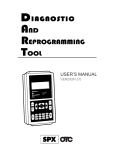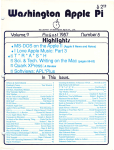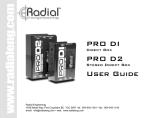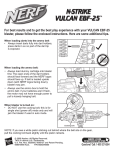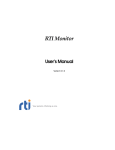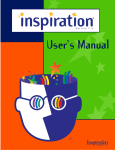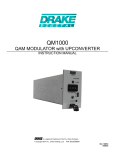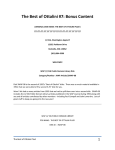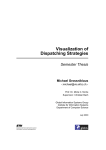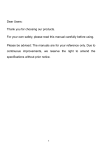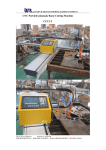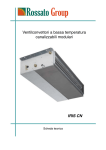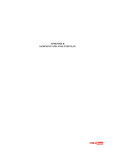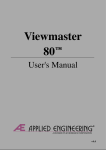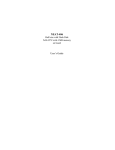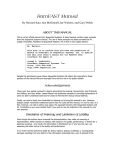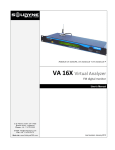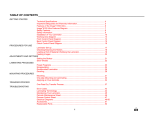Download Vulcan 2+ 2e v1.3 Manual - downloads.reactivemicro.com
Transcript
Table Of Contents
INTRODUCTION - ABOUT TIlE VULCAN
V
The Software
ProDOS 8
Backup II
The Partition Manager
Park Heads
The Separate Disk
The Vulcan’s Fan
The Power Supply
Running Programs from Vulcan
v
v
v
vi
vi
vi
vii
vii
vii
CHAPTER ONE - //E AND ][ PLUS INSTALLATION
Installation Procedure
1
9
CHAPTER TWO - USING PRODOS 8
Maximum Files in the Root Directory
Booting from Vulcan
Booting from RamFactor
Warm Booting
Copying a Different ProDOS 8 System to the Vulcan
CHAPTER THREE - TIlE PARTITION MANAGER
First...
About the Partition Manager
Backing Up the Partitions
Running the Partition Manager
The MODIFY Mode
Entering MODIFY Mode
1
9
9
9
9
9
11
11
11
12
12
13
13
Table of Contents
i
Locking/Unlocking Partitions
Partition Names
Setting the Partition Size
Turning Partitions On or Off
Selecting the Operating System
Selecting the Boot Partition
Leaving MODIFY Mode
Canceling/Saving Changes
Formatting
Print
Quit
Final Check
Quitting
14
14
15
18
19
19
20
21
21
22
22
22
23
CHAPTER FOUR - D O S 3 . 3 , P A S C A L , A N D C P / M
DOS 3.3
Patched DOS 3.3 Notes
Volume Sizes
Copying Files to the DOS 3.3 Partition
Other DOS 3.3 Goodies
CP/M
Pascal
25
25
27
27
27
31
32
33
CHAPTER FIVE - BACKING UP THE VULCAN
Introduction
Backup II for ProDOS
Number of Disks Required
Suggested Backup Schedule
Before You Back Up
Running Backup II
Backup Entire ProDOS Partition
Backup Modified Files
35
35
35
35
36
36
36
37
39
ii
Vulcan
Listing Files
Restore Individual Files
Restore Entire Volume
41
41
43
APPENDICES
A: Trouble shooting
If you can’t boot
ProDOS Can’t Find All Four Vulcan Partitions
Two Drive Devices per Slot
Eight Total Drive Devices
B: Hardware
Switches
What They Do
How To Set Them
Remote Light Jack
C: Bird’s Better ‘Bye’
‘What It Is
How to Use It
D: Using Filer to Copy to Vulcan
E: “Interleaver” (20 and 40 Megs only)
About Interleave
Using Interleaver
F: A Brief ProDOS Tutorial
Operating System
Naming Volumes
Root Directory and Subdirectory
Pathname
System Files
Additional Resources
G: Getting Help
45
47
47
47
47
47
49
49
49
49
50
51
51
51
53
55
55
56
58
58
58
58
59
60
60
61
Returning a Product
RMA Number, “Attention” Sheet, and Invoice
When You Ship
When We Receive
INDEX
? 62
62
63
63
64
Table of Contents
iii
Æ
Vulcan
iv
Vulcan
INTRODUCTION
About the Vulcan
The Software
The Vulcan comes preformatted and set into ProDOS
partitions.
Computer
Size
#of Preset
Partitions
Contents
//e, ][+
20 Meg
1
ProDOS 8, Utils
//e, ][+
40 Meg
2
1) ProDOS 8, Utils
2) Empty
//e, ][+
100 Meg
4
1)
2)
3)
4)
ProDOS 8, Utils
Empty
Empty
Empty
ProDOS 8
ProDOS 8 can access a maximum of two drive devices per
slot (except for slot 5 which can recognize up to four).
The ProDOS 8 operating system included on Vulcan and
the Vulcan’s 5.25” floppy disk is a version modified to
recognize up to four drive devices per slot. If you plan to
boot from another disk or if you create another ProDOS 8
partition on the Vulcan you’ll need to copy the modified
ProDOS to be able to access more than two Vulcan
partitions.
Backup II
Backup II is Apple’s ProDOS backup utility for backing
up the ProDOS partitions. For instructions on using
Backup II refer to the Chapter 5.
Introduction - Getting Started
V
The Partition Manager
Because ProDOS allows a maximum of 32 Meg per drive
device, the 20 Meg Vulcans are shipped with one
formatted ProDOS partition, the 40 Meg Vulcans are
shipped with two formatted ProDOS partitions and the 100
Meg Vulcans are shipped with four formatted ProDOS
partitions.
The Partition Manager program (PART.MANAGER) allows
you to configure the Vulcan in up to 16 different
segments. However, you don’t need to set up a separate
partition for each program. Set up your own partitions if
you want to run operating systems other than ProDOS or
if you want to resize and add to the existing ProDOS
partitions. Any partition can be set up to run under
ProDOS, DOS 3.3, Pascal, or CP/M. The Partition Manager
allows you to resize partitions, format partitions, activate
partitions and select which partition to boot.
The ProDOS 8 version provided on the Vulcan and the
floppy disks has been patched to allow ProDOS 8 to use
four ProDOS partitions from the Vulcan instead of only
two (the ProDOS restriction).
Park Heads
The Park Heads program moves the hard drive’s
read/write heads to a “safe” position on the disk. This
prevents the heads from bouncing on a piece of the disk
and destroying the data there. You need to run Park
Heads only when you plan to move the Vulcan or your
computer. Run it just before turning off your computer.
*
Note: 100 Meg drives have an auto-park feature
which moves the heads to the “safe” position each
time you shut down.
The Separate Disk
The 5.25” disk is two sided. The front side contains
Vulcan’s ProDOS 8 utilities including Backup II, Partition
Manager, Park Heads, and ProDOS patcher. The back side
has the DOS 3.3 system and various DOS 3.3 utilities
including iE’s version of FID, which support the Vulcan.
(Refer to the DOS 3.3 section of Chapter 4.)
vi
Vulcan
The Vulcan’s Fan
The Vulcan’s fan keeps the power supply and hard drive
cool. If you have several powerful cards in your
computer however, consider a separate cooling fan for
your system.
The Power Supply
The Vulcan’s built-in power supply replaces your
computer’s power supply. Applied Engineering designed
Vulcan’s power supply to be both more compact and
more powerful than the one included with your
computer.
Features
◊
◊
◊
◊
◊
◊
◊
◊
◊
FCC Certified
Light-weight aluminum case
Externally accessible fuse with spare.
110/220 VAC, 50/60 Hz
Built-in Fan
Cool Running
- 40˚C w/fan
- 60˚C w/o fan under full load
Power components to case
70 full watts w/o fan
Adjustable 5 Volts DC
Running Programs from Vulcan
You don’t need to create a separate partition for
each program you want to run. The number of
programs each partition can hold is limited only by the
space you have allotted to the partition. Copy the
programs to the Vulcan partition just as you would copy
from one floppy disk to another.
Filer is included with Vulcan. Filer is an Apple copy
program that you can use to copy single files, multiple
files or entire disks to the Vulcan. Refer to Appendix D
for instruction on using Filer.
Introduction - Getting Started
vii
Vulcan’s ProDOS includes the program launcher, Bird’s
Better ‘'Bye’ (BBB). Refer to Appendix C for instructions
on using BBB.
If you have been using another program launcher to run
your programs, you can continue to use it to run
programs from the Vulcan.
Copy Protected Programs
Some programs are written to run only from floppy disk
and cannot be run from a hard disk. Most programs will
tell you if they are copy protected.
viii
Vulcan
CHAPTER ONE
lIe and ][ Plus Installation
Installation Procedure
You’ll need Phillips screwdriver to install the Vulcan.
When you have one, follow the instructions below.
1)
Turn Off and Open Computer
Turn off the computer and then pull up on the two tabs at
the rear of the case lifting the lid up and towards you.
Remove the IIe or ][ Plus cover
2)
Remove Cards
If you have a cards installed into the other slots, you’ll
need to remove them to give yourself room to work.
Refer to your slot cards’ manuals for proper removal.
3)
Remove Power Supply
i)
Unplug external cord from back of computer.
This is the cord that runs from the back of the computer
to the wall socket. Unplug it from the back of the
computer and from the wall socket as well.
Ch. 1 - lI e and ][ Plus Installation
ii)
Unplug internal cord from motherboard.
The internal power cord is the multi-wire cord running
from the power supply toward the back of the
motherboard.
Squeeze the left and right side of the plug to release, then
pull up.
Unplug Internal Cord
iii)
Remove screws.
Turn the computer on its left side. On the bottom of the
computer you will find four screws in a rectangular
pattern the size of the power supply. While firmly holding
onto the power supply, remove the four screws. When all
four are removed, lift the power supply out of the case.
4)
Remove Vulcan from Packing.
5) Check Voltage Setting
The switch setting on back of the Vulcan must be set to
the proper voltage (115 in the United States).
6)
][ Plus Users Only Attach Riser Plates
--
The two metal plates (included) must be attached to raise
the Vulcan over the ][ Plus motherboard. Use four of the
included Phillips screws to attach the plates.
*
2
Vulcan
Note: Attach the plate so that the screws are to the
side of the female stand-offs toward the long
straight edge of the Vulcan (see picture following).
Attach Riser Plates (][ Plus Only)
7)
Insert Vulcan
With the computer still on its side, turn the Vulcan at an
angle and insert it into the opening left by the old supply.
*
][ Plus Note: Some speakers will be in the way,
others will not. If you need to move the speaker,
pry it up (it is glued not screwed) and use the
included adhesive strip to reattach it in an out of
the way part of the case.
Insert Vulcan
Ch.1 - II e and ][ Plus Installation
3
8)
Use four screws Provided to secure Vulcan.
Align the holes on the bottom of the Vulcan and the
computer case. Do not use the screws from the old power
supply. Do not over-tighten the screws.
*
9)
If Plus Note: If the holes don’t align, try turning
one or both of the bottom plates around.
Plug Internal Power Cord Into Motherboard.
Return the computer to its normal position. The Vulcan’s
internal power cord plugs into the motherboard in the
same place as the old power supply’s cord. The
connector’s push tabs should be toward the left and right.
*
Note: Do not force the connector; it will attach
easily in one direction.
Plug Internal Cord Into Motherboard
10)Set Switches According to Slot
The Controller Card will work from any slot. Before
installing the card, note the following:
◊
◊
4
Vulcan
Do not install the card into the Memory Expansion
slot.
We recommend installing the controller card into
slot 7. The //e and ][ Plus will look for a boot
source starting at slot 7 and working down. If you
want to boot from the Vulcan it will need to be in
a higher slot than your other drives.
◊
Pascal users need to install the card in slot 4, 5, or
6. Pseudo slotting must not be enabled.
Check the switches on the card. The switch block
is the red rectangular box toward the bottom right
of the card. The switches should be set as shown
below.
Note: You’ll probably need to remove the tape
covering the switches.
◊
*
Switch 3, ][ + Boot Enable
Leaving this switch open allows a II+ or an
unenhanced IIe to boot directly from the hard
disk. The Vulcan still must be the first drive device
encountered (usually slot 7). If the hard disk is not
o be the boot device in these systems, this switch
should be closed. In a //e retrofit or an enhanced
//e, this switch should also be closed.
Switch 3 Set to Boot Enable for
][ Plus and Unenhanced lIe
Switch 3 Setting for
Enhanced lIe
*
Note: For a complete description of the functions
of the switches, refer to App. D.
Use a small, pointed object, like a wooden toothpick
or bent-out paperclip to change a switch setting. The
circle on each switch represents the end that should
be pressed for a standard ][+ and unenhanced //e setup.
Oh.
1 - lIe and ][ Plus Installation 5
Slot 7 Pseudo-Slotting
If your slot 7 does not have a card in it, but is
blocked, you can install the card into another slot and
make it appear to be in slot 7. This process is called
pseudo-slotting.
If you want to pseudo-slot the card, you’ll need to set
switch 2 to Open and 4 to Closed.
Switches Set for Pseudo-Slotting
If you want the card to appear to be in the slot in
which it is installed, set switch 4 to Open. Switch 2
can be Open or Closed.
1 1 ) Insert Card Into Slot
Align the gold “fingers” of the controller card’s edge
connector with the slot; then use the heel of one hand
to push the card down into the slot and seat it firmly.
Insert Controller Card into Slot
1 2 ) Connect Cable from Vulcan to Controller Card
Attach the wide flat cable from the hard drive to the connector
on the controller card. The connector and socket are keyed so
that they will attach in only one way.
6
Vulcan
Make sure that the cable connector is firmly seated in the
controller card socket.
13)Reinstall Any Cards Removed
Replace any cards you have removed for the installation
following those cards installation instructions.
*
WARNING! IF YOU HAVE A CARD IN SLOT 1, use
the insulator card (2” x 6”) included with the
Vulcan package. Applied Engineering will not be
responsible for damage to any other products so
be careful when reinstalling your cards.
14)Close Computer
Replace the lid by sliding the front of the lid in first,
lowering the back edge into place and then pushing gently
and firmly on the back corners of the lid until it pops into
place.
15)Plug In External Power Cord
This is the same cord as your original power supply used.
Connect it to the back of the Vulcan and then plug it into
the wall socket.
Hardware installation is complete. Congratulations!
What Now?
Using ProDOS
You may want to use only the ProDOS 8 operating system
included with the Vulcan. If that’s the case, read the next
chapter.
Dividing the Partitions
*
Note: You don’t need to create a separate partition for each
program you want to run.
If you’d like to set up the hard drive so that it appears to
be several separate hard disks, refer to Chapter 3 now.
Most users can use the drive as shipped and won’t need to
set up separate partitions.
Ch.1 - lIe and ][ Plus Installation
7
Loading Different Operating Systems
If you’d like to use your Vulcan under Pascal, CP/M or
DOS 3.3 you’ll need to read Chapters 3 and 4.
8
Vulcan
CHAPTER Two
Using ProDOS 8
Maximum Files in the Root Directory
ProDOS 8 limits the maximum files in the root directory
to 51. You may, however, put a virtually unlimited number
of files into subdirectories.
Booting from Vulcan
Most likely, you will want to boot ProDOS from the
Vulcan; it’s much faster than booting from floppy and you
don’t have to put in and take out disks.
When powered up, the //e and ][ Plus computers look for
a bootable device starting at slot 7. Your][ Plus or //e will
boot directly from the Vulcan if it occupies a slot with a
higher number than any other boot device.
*
Note: If you’re using pseudo-slotting, the Vulcan
will be the first device found.
Booting from RamFactor
If you have a RamFactor with a RamCharger and want to
boot from it, you’ll need to put the Vulcan controller in a
lower slot than the RamFactor.
Warm Booting
To warm-boot the Vulcan, use the PR#s command where
“s” is the Vulcan’s slot. If you’re pseudo-slotting, the
command will be PR#7.
Copying a Different ProDOS 8 System to the Vulcan
The ProDOS 8 file we’ve included on the Vulcan and the
5.25” disk are modified to allow ProDOS 8 to recognize
more than two Vulcan partitions. If you’re booting from
other ProDOS 8 disks or if you want to set up another
partition to boot, copy the ProDOS 8 file from the first
partition or from the Vulcan floppy disk to the boot partition.
Ch. 2 - Setting Up the Software
9
The first two ProDOS partitions which are turned on will
be drives 1 and 2 of the Vulcan’s slot. If you have more
than 2 turned on, the other(s) will show up as drives in
another slot (probably 1). This doesn’t interfere with any
other device you have in that slot.
10
Vulcan
CHAPTER THREE
The Partition Manager
This chapter is an in-depth look at the Partition Manager.
You may want to read over the section headings in this
chapter and then go on to Chapter 4 for instructions on
how to quickly set up a partition for DOS, Pascal, or
CP/AM.
First...
The first thing you should know about the Partition
Manager (PM) is that it is a formatting utility.
Modifications to the size of a partition and switching
operating system change the basic structure of the disk
and will destroy any data currently within the partitions
you are resizing. So, before using the Partition Manager,
save any data that you want to keep and restore it after repartitioning.
About the Partition Manager
The Partition Manager is a ProDOS program that lets you
segment the hard disk. You can use these segments, or
partitions, as if they were large floppy disks or individual
hard disks. Each can have its own name, hold its own files,
even run under any one of four different operating systems.
* Reminder: You don’t need to create a separate
partition for each program you want to run.
The Partition Manager allows a maximum of 16 separate
sections. ProDOS and CP/M operating systems can both
have up to four partitions turned on at the same time. DOS
3.3 and Pascal allow for only 2 sections active at the same
time. You could set up all 16 partitions as ProDOS, for
example, but only four of these can be accessed (turned
on) at one time.
Ch. 3 - The Partition Manager 11
*
PC Transporter users: You can also use the hard
disk as an MS-DOS storage device by creating an
MS-DOS hard volume on a ProDOS partition.
Follow the directions in the PC Transporter
manual for using a hard disk.
Backing Up the Partitions
Make ProDOS backups with Backup II, included on the
Vulcan drive. Make DOS 3.3 backups with FID, included
on Vulcan’s DOS 3.3 disk. Backup Pascal and CP/M with
the programs you currently use for copying files under
these systems.
Running the Partition Manager
From Disk
Boot the 5.25” ProDOS Utilities disk and choose Partition
Manager from the menu.
From Basic
From BASIC, set your current prefix to the VULCAN disk
and enter -PART.MANAGER at the BASIC prompt.
Other Launchers
Follow the instructions for the launcher you use to run
the application PART MANAGER.
.
12
Vulcan
Once the program is run, you’ll see the current partition
settings. A sample screen is shown below:
AE VULCAN
MODIFY
LOCK NAME
1
AE.1
2
AE.2
3
4
5
6
7
...
PARTITION MANAGER
FORMAT
PRINT
SIZE
32767.5K
9460.0K
• OK
• OK
• OK
• OK
• OK
ON
*
*
(V x.x)
QUIT
SYSTEM BOOT
PRODOS *
PRODOS
CLEAR
CLEAR
CLEAR
CLEAR
CLEAR
The PM Menu
The MODIFY Mode
While in modify mode you can enter the Partition
Manager options table to configure your hard drive into
different partitions.
Entering MODIFY Mode
Use the left and right arrow keys (or J and K keys) to
select MODIFY from the top menu bar and then press
<return>.
While in MODIFY mode, the Partition Manager is set up
like a spread sheet. Use the arrow keys to move from cell
to cell.
Ch. 3 -The Partition Manager 13
To move the cursor
Use
up
“I” or up arrow
down
“M” or down arrow
left
“J” or left arrow
right
“K” or right arrow
Locking/Unlocking Partitions
Locking a partition protects that partition from being
written to, reformatted, erased or resized. A locked
partition functions the same as a write protected disk.
To lock or unlock a drive, while in MODIFY mode:
1)
2)
Move the cursor to the LOCK column of the
partition you want to lock or unlock. Locked
partitions are marked with an asterisk (*).
Press the <return> key to toggle between locked
and unlocked.
Partition Names
Each partition can have its own name. The name you
assign a partition is an easy way for you to keep track of
the partitions when setting the boot drive and active
partitions.
The operating systems will not actually use these names
except as defaults when formatting. So, you could name a
ProDOS partition “LAURA” under the Partition Manager,
format the partition using the default, LAURA, and then, in
ProDOS 8 you can rename it STUFF.O.LAURA.
Name Rules
Partition names basically follow the. rules of ProDOS
names.
These rules are:
1)
2)
3)
*
14
Vulcan
Name can include letters, numbers, or periods but
not spaces.
Name must begin with a letter.
Name can be up to 10 characters long.
Note: ProDOS actually allows names to be 15
characters long, however, the PM allows only 10.
Name the Partition
To name a partition, while in MODIFY mode:
1)
2)
3)
4)
Move the cursor to the NAME column of the
partition you want to name.
Press <return>.
Type in the name for the partition. (Refer to Name
Rules above for acceptable names.)
Press <return>
Canceling Rename
To cancel a rename while in the ENTER NAME mode,
press <esc>. The name will be left as it was.
Setting the Partition Size
When we shipped your Vulcan, we allotted the maximum
allowable space to the first partition with a ProDOS
system installed. ProDOS allows a maximum of 32
Megabytes per drive. Any available disk space above the
maximum is shifted to the next partition(s).
If you decide to resize the partitions remember this
important guideline:
BACK UP!
When you enlarge a partition, you’re taking space away
from another partition. The space you take away may be
the portion that contains important files or applications.
Backup copies of the partitions let you correct any slips
you might make.
The partition you have selected will give space to or take
space from the next partition(s) down.
Sizing Rules
When sizing, keep in mind the following rules:
1) You must have the operating system of both the
partition you are resizing as well as the partition
next in line set to CLEAR.
2) Any sequential files that are also set to CLEAR may
also be modified.
Ch. 3 -The Partition Manager
15
3)
4)
5)
6)
7)
8)
ProDOS allows a maximum partition size of 32
Meg.
DOS 3.3 allows a maximum partition size of 32 Meg
made up of several volumes which must be either
140K or 400K.
In DOS 3.3, the number of 140K and 400K volumes
contained in a single partition are set from the
format option.
In DOS 3.3, you’ll need at least one 140K volume
to make the partition bootable.
Pascal allows a maximum partition size of 16 Meg
(16,383.5K -- $7FFF).
CP/M allows a maximum partition size of 8 Meg
(8192.0K -- $4000).
Sizing the Partition
*
IMPORTANT : If you currently have files within the
partitions you are resizing, you could lose these files.
Back up the partitions that will be involved in resizing
before making any changes.
When resizing a partition, you’ll need to:
1)
2)
Unlock the partitions that will be involved in
resizing. Refer to “Locking/Unlocking Partitions”
above.
Set the partition to CLEAR.
This allows you to take space away from one partition
and distribute it to others.
To set the SYSTEM to CLEAR, while in MODIFY
mode:
i) Move the cursor to the SYSTEM column of the
partition you want to resize.
ii) Press <return>.
iii) Use the arrow keys to toggle through the
system options until you reach CLEAR.
iv) Press <return>
3)
16
Vulcan
Set the partition size.
To select the size for a partition:
i) Move the cursor to the SIZE column of the
partition you want to change.
ii) Press <return>.
iii) Select the size for the partition using the same
keys that move the cursor.
To
increase size by 32K
decrease size by 32K
increase size by 0.5K
decrease size by 0.5K
Use
“ I” or up arrow
“ M” or down arrow
“ K” or right arrow
“ J” or left arrow
iv) Press <return>
The sizes are dependent upon the total available space. All
of the hard disk memory must be allocated to one
partition or another. When you shift space from any
partition, it will affect the space of the next partition.
Allot the sizes to higher number partitions in a “trickle
down” method; pass memory from the partitions with
lower numbers to the partitions with higher numbers.
LOCK
1
2
3
4
5
6
7
...
NAME
SIZE
ON
20000.0K
5000.0K
5000.0K
5000.0K
2500.0K
2500.0K
.0K
SYSTEM
CLEAR
CLEAR
CLEAR
CLEAR
PASCAL
CP/M
CLEAR
BOOT
In the example above, partitions 1-4 would be the only
ones affected by a SIZE change because 5 and 6 are not
clear.
*
Important: After changing the size of the partition,
you’ll need to reset the SYSTEM and FORMAT.
Ch. 3 -The Partition Manager
Turning Partitions On or Off
Although you can segment the drive into 16 partitions,
due to the restrictions imposed by the various operating
systems, all 16 cannot be active at once. You can have four
active partitions at one time under ProDOS and CP/M.
DOS 3.3 and Pascal, however, allow only two partitions at
one time.
You can decide which partition you want to use during a
particular session by turning them ON (*) or OFF (blank).
When a drive is off (inactive), it will not be recognized by
the computer but all data stored within that partition is
saved. It’s like saving files to a disk and then pulling the
disk out of the drive.
Because ProDOS can recognize only 8 online volumes,
you may want to have less than four drives active
depending on your system’s setup.
For example, if you have two 5.25” drives, two 3.5 drives
and a RAM disk, you would only want three Vulcan
partitions active. If you have four turned on, one drive
unit will not show up properly.
Another example: teachers can use different partitions to
store different classes’ files. They can turn off all the
partitions except for the current class’.
To turn the partition ON or OFF while in the MODIFY
mode:
1)
2)
*
3)
18
Vulcan
Move the cursor to the ON column of the partition
you want to turn ON or OFF.
Press <return> to toggle between the ON setting
(*) and the OFF setting (blank).
Note: If you have the maximum number of
partitions for the operating system turned ON,
when you attempt to turn another one ON, the PM
will beep and not let you.
Use the arrow keys to move to your next option
or press <esc> to return to the main menu.
Selecting the Operating System
Under the SYSTEM option, the Partition Manager gives
you five settings from which to choose. These are:
PRODOS
PASCAL
DOS 3.3
CP/M
CLEAR
IMPORTANT: If you currently have files within the
*
partitions for which you are changing the SYSTEM
setting, you’ll lose these files. If there is
information that isvaluable to you on these
partitions, back them up before making any
changes.
When selecting an operating system, while in the MODIFY
mode you’ll need to:
1)
Unlock the partitions for which you want to chose
a system. Refer to “Locking/Unlocking Partitions”
above.
2) Move the cursor to the SYSTEM column of the
partition you want to resize.
3) Press <return>.
4) Use the arrow keys or I, J, K, M keys to toggle
through the system options until you reach the
desired system.
5) Press <return>.
6) Changing systems automatically turns off that
partition so turn on the partition if you want it
active.
After you’ve selected a system, you’ll still need to format
the partition by using the FORMAT option before you can
actually use the partition for file storage and booting.
Selecting the Boot Partition
The boot flag tells the computer which partition to go to at
startup.
Ch. 3 - The Partition Manager
19
Booting Rules
When selecting a boot partition keep the following rules
in mind:
◊
◊
◊
◊
◊
◊
◊
You can have only one partition set to boot.
The partition you set to boot can be any of the
four operating systems.
The boot partition does not have to be the first
partition of that operating system.
The boot partition must have the boot files
required for that system copied into the partition.
Under DOS 3.3, the first volume of the boot
partition must contain the boot files.
To boot from a Vulcan partition, you’ll need to
have the Startup Slot set to the slot containing the
Vulcans controller card or to slot 7 if you're
pseudo-slotting the card. (Refer to Ch. 1, Slot 7
Exception, for information about pseudo-slotting.)
If you do not set the Startup Slot to the Vulcans drive, the
computer will ignore the Partition Manager’s boot flag.
Set Boot Partition
To set the boot partition, while in MODIFY mode:
1)
If there is not already an asterisk in the boot
column of the partition you want to boot from,
move the cursor to that column.
2) Press <return>.
The asterisk will be removed from its Current position and
will appear in that column you currently have selected.
Leaving MODIFY Mode
Before Leaving
Before you leave MODIFY mode, make sure your
settings are the way you want them.
◊
◊
Vulcan
Have you set the partition to the system you
want?
Are the partitions you want active turned
ON?...
How To Leave
To leave the MODIFY mode and return to the top of
the menu, press <esc>. If you have made any changes
to the partitions, you will be asked if you want to save
(UPDATE) or cancel (UNDO) the modifications. (See
below.)
Canceling/Saving Changes
When you leave the MODIFY mode, you’re asked if you
want to UPDATE or UNDO the changes you have made.
To
Press
Save modifications
Y
Cancel modifications
N
Return to MODIFY mode
<esc>
Updating the changes will save the changes you have made
and leave you in the main menu. You’ll need to format any
modified partitions to make them useable.
Undoing the modifications will reset the partition table to
the settings it had before you last entered the MODIFY
mode and leave you in the main menu.
<esc> will return you to the last position you were in on
the partition table with all recent modifications unchanged.
Formatting
*
Note, Formatting will completely erase everything
that may still reside on the partition being
formatted. You should have all important files
backed up by this time.
Once you have your partitions set to the desired size and
operating system, you’ll want to format the partition for
their particular system so they can be written to and read
from.
*
Note, You don’t need to alter the partitions to
reformat; you can leave the partitions unmodified
and still use the format command.
Ch. 3 - The Partition Manager 21
To format a partition:
1) While in the top part of the menu, select FORMAT.
2) Press <return>.
A selection bar will appear over the partition rows.
3)
Use the arrow keys to select the partition you
want to format.
4)
When you have the selection bar over the desired
partition, press <return>.
The Partition Manager will format the partition according
to the system you have chosen for that partition.
*
Note. In DOS 3.3, you can set up several different
volumes per drive. You’ll be asked how many
small volumes (140K) you want. The rest of the
space will be used for large volumes (400K). As
you select how many 140K drives you want, the
format table will update the number of 400K drives
to be formatted and tell you how much disk space
is unused. You’ll need at least one 140K drive if
you want to boot from that DOS partition.
5)
Select another partition to format or press <esc> to
return to the main menu.
Print
The PRINT option lets you print the current PM screen if
you have a printer online. You may want to print after
making modifications to the PM to remind you of your
current settings.
To print the current setup, select PRINT from the top part
of the menu, type in the slot number of your printer (or
<esc> to cancel) and then press <return>.
Quit
When you’re ready to leave the Partition Manager, use the
QUIT option.
Final Check
Before you leave the PM, check your settings to make
sure they are as you want them.
Vulcan
◊
◊
◊
Have you formatted the resized and new
partitions?
Are the partitions you want active turned on?
Do you have the boot flag set to the proper
partition?
Quitting
You can leave the PM by selecting QUIT from the top part
of the menu followed by <return>.
Once you’ve saved the modifications and formatted the
partitions, you can copy files to the active partitions or
restore files from the backups.
Ch. 3 -The Partition- Manager
23
Æ
Vulcan
24
Vulcan
CHAPTER FOUR
DOS 3.3, Pascal, and CP/M
If you rarely use DOS 3.3, Pascal, or CP/M you’ll
probably be better off running them from floppy and
using your Vulcan to run ProDOS only. However, if
you’re a frequent user of DOS 3.3, Pascal, or CP/M read
this chapter to quickly set up partitions for the different
systems.
You must be within a partitions operating system before
you can copy files to it. For example, you can’t copy to
the DOS 3.3 partitions while in ProDOS. Only the
partitions that are currently ON and contain the system
currently booted will be recognized.
Use this chapter to quickly set up partitions for DOS 3.3,
Pascal or CP/M. Refer to Chapter 3 for specific
instructions and rules about using the Partition Manager.
DOS 3.3
DOS 3 . 3
The following is an abbreviated, step-by-step guide to
setting up a DOS 3.3 partition. The instructions assume that
your Vulcan is either installed in or pseudo-slotted to Slot
7 and that your 5.25” Vulcan Utility disk is in Slot 6, Drive
I. If you have your system configured differently, modify
the steps accordingly.
1)
2)
3)
4)
5)
Boot the Vulcan and run the Partition Manager.
(Refer to the previous chapter for instructions.)
Choose MODIFY” from the Partition Manager
menu.
Set up the number of partition(s) you want for
DOS 3.3 and turn the partition(s) on. You can turn
on up to two DOS 3.3 partitions at a time.
Format the partition(s). The first volume must be a
140K volume for the partition to be bootable.
Quit the Partition Manager.
Ch. 4 - ProDOS 8. DOS 3.3, Pascal, and CP/M
25
6)
7)
8)
9)
10)
11)
12)
13)
14)
Boot the back of the Vulcan 5.25 disk. (Run
BASIC.SYSTEM, type PR#6 at the prompt and then
press the <return> key.)
From the menu, select “8” Install Vulcan Patch
then press any key to return to the menu.
Press “9” to quit to the BASIC prompt.
Type IN#7 and press Return. This informs DOS 3.3
that your Vulcan is in Slot 7. You should see two
flashing cursors on your screen.
Insert the disk in the drive containing the HELLO
program you want to load onto the Vulcan. You
can leave the Vulcan DOS 3.3 Utilities disk in the
drive if you want to boot into the Main Menu.
Type “LOAD HELLO, S6” and press <return>.
Type “INIT HELLO, S7,D1,V1” and press <return>.
If an I/O error occurs, you didn’t install the
Vulcan patch. Go back to step 6.
With the Vulcan DOS 3.3 Utilities disk in 56, Dl,
type, “RUN HELLO, S6.”
Press “8” - INSTALL VULCAN PATCH and then
press any key to return to the menu, (Running
HELLO removed the patch.)
15) Press “5” -- AE FID.
16) Press “1” -- COPY FIL ES and <return>.
SOURCE SLOP 6
DRIVE? 1
DESTINATION SLOT? 7
DRIVE? I
VOLUME? 1
When copying other DOS 3.3 files to the Vulcan,
run FID and enter the desired Destination Volume.
For example, with a 1340K DOS 3.3 partition, you
may have three 400K volumes in addition to the
first volume of 140K. You can set the Destination
Volume to any one of the four.
FILENAME? =
The equal sign is a wildcard meaning “copy all
files,” If you want to copy only specific files, enter
the names of the files at this prompt.
26
Vulcan
DO YOU WANT PROMPTING? (Y/N) N
17) Press 9” to quit when the copy routine is
complete.
Booting from the DOS 3.3 Partition
To make the DOS 3.3 partition bootable, run the Partition
Manager and select the DOS 3.3 partition as the Boot
Partition.
Patched DOS 3.3 Notes
The version of DOS you’ve installed with the INIT HELLO
command is a patched version. The patched version allow
DOS to accept lowercase letters, reduces loading time, and
corrects an error in the append command.
Do not use this version to INIT floppy disks. The patched
version will look for a Vulcan and will not boot if it
cannot find one. Instead, use the unmodified version of
DOS 3.3 included on the floppy disk to INIT other floppy
disks.
If you change the Vulcan’s slot, you’ll need to repeat the
process detailed in the two sections above. The patched
version expects to find the Vulcan in a particular slot. If
you switch slots, DOS wont be able to find the Vulcan
until you repeat the necessary steps.
Volume Sizes
The sizes of the DOS 3.3 volumes depend upon the sizes
you chose while in the Partition Manager. Use the chart
below to determine the maximum number of files each of
your DOS 3.3 volumes will hold.
Partition Size
140K
400K
Maximum Files
105
217
Copying Files to the DOS 3.3 Partition
Non copy-protected DOS 3.3 files can be copied to the
DOS 3.3 partition(s) using IE’s own version of Apple FIle
Developer program (FID) included on the Vulcan’s DOS
3.3 floppy disk. By now, you’ve probably already used
FID to copy the boot files to your DOS partition.
Ch, 4 - ProDOS 8, DOS 3.3, PascaI, ond CP/M
27
Copying Files with FID
FID is a binary program which will copy DOS 3.3 files and
applications from one disk to another. Apple’s original
version does not recognize hard drives as an option.
We’ve modified the version included on the Vulcan’s DOS
3.3 disk to recognize the Vulcan’s DOS 3.3 partitions and
allow you to copy files to them.
To execute AE FID,
Either:
I)
2)
Boot Vulcan’s DOS 3.3 floppy disk.
Select AE FID from the main menu.
Or:
1)
2)
Run BASIC.
Type BRUN AE.FID at the BASIC prompt (])
with Vulcan’s DOS 3.3 floppy disk in an online drive.
Once the program is running, follow the steps below to
copy files to your DOS 3.3 partition(s).
*
Note. The following instructions assume that
you’ve already formatted the volume you’re
copying to and that you are copying from your
Slot 6, Drive 1 5.25” drive to a Vulcan partition in
Slot 7.
You can exit from most parts of the program by pressing
<esc>
TYPE
(followed by <return>
1
6 (or floppy drive slot)
1
7 (or Vulcan’s Slot)
28
Vulcan
RESULT
Selects option I (Copy Files)
from the AE FID main menu.
Specifies slot 6 as the source
slot.
Specifies drive I as the
source drive.
Specifies slot 7 (or
whichever slot Vulcan is set
up for) as the destination
slot.
1
1
AE .FID (or =)
Specifies drive I as the
destination drive.
Specifies volume 1 as the
destination volume.
Specifies filename of first
file to copy. The equal
sign (=) is a wild card character
meaning “copy all”.
Repeat the above steps for each file you want copied or, if
you’ve pressed “=“, you won’t need to repeat the steps for
individual file copying.
S (or any key)
9
CATALOG
Returns you to the AF FID
menu.
Quits and returns you to the
BASIC prompt.
Lists the directory of the
destination disk.
The Rest of FID
Following is a description of each of AF FID’s menu
options.
< 1 > COPY FILES
As in the instructions above, this command lets you
transfer files from source to destination. Use "="
(equal sign) for “copy all.” You can also use it to
copy all files with certain letters, For example, =FX=
will copy all file with EX in the name.
Prompting will list each file and wait for you to type
“Y” to copy or “N’ to skip to the next file.
<2>
CATALOG
This command gives you a directory listing of the
DOS volumes currently online.
The first time you select this option in a session,
you’ll be asked to specify the slot, drive, and volume.
The subsequent times, you’ll he returned to the
volume last chosen. To view a different volume, use
<7> RESET SLOT AND DRIVE. before pressing <2>
again.
Ch. 4 - ProDOS 8, DOS 3.3, PascaI. ood CP/M
29
<3>
SPACE ON DISK
this command to show the amount of space
(sectors) free and used for each volume.
140K volumes will have 528 sectors free after
initializing. 400K volumes will have 1536 sectors free.
If you use INIT to write a boot image to volume 1,
you’ll have 490 sectors free. (V1 must be a 140K
volume).
The first time you select this option in a session,
you’ll be asked to specify the slot, drive, and volume.
The subsequent times, you’ll be returned to the
volume last chosen. To view a different volume, use
<7> RESET SLOT AND DRIVE before pressing <3>
again.
<4>
UNLOCK FILES
To unlock individual files, use this command.
The first time you select this option in a session,
you'll be asked to specify the slot, drive, and volume.
The subsequent times, you’ll be returned to the
volume last chosen. To work with a different volume,
use <7> RESET SLOT AND DRIVE before pressing
<3> again.
Use “=“ (equal sign) for “unlock all. This is most
often easier than trying to remember specific
filenames.
When you use you’ll be asked if you want
prompting. Prompting will list each file and wait for
you to type “Y’ to unlock or “N” to skip to the next
file.
<5>
LOCK FILES
Same as above but for Locking instead of Unlocking
individual files.
<6>
DELETE FILES
Permanently erases files from the disk. DELETE uses
the same operation method as LOCK and UNLOCK.
<7>
Vulcan
RESET SLOT & DRIVE
Use this command to reset the slot, drive, and volume
selection of options 1-6 and 8. After selecting this
option, the other options will again ask you to specify
the slot, drive, and volume numbers.
<8> VERIFY FILES
This option makes sure that the files are as they
should be. Same operation method as UNLOCK.
<9>
QUIT
The QUIT option exits FID and returns you to the
main menu or to the BASIC prompt.
Other DOS 3.3 GoOdies
We’ve included some other helpful utilities on the DOS
3.3 disk
Run Volume 2 Hello - Runs Hello program on V2 of
the same partition.
Park Heads - Moves hard drive’s heads to safe place.
Use just before shut down.
Catalog All Volumes - complete listing of all DOS 3.3 volumes
in active partition. (Press any key for next
volume, <return> or <esc> for main menu.)
Edit Volume Names - allows you to changes names
of volumes.
AE FID - utility that enables you to copy, lock, unlock,
delete, arid verify files and more.
Partition Manager - DOS version of Vulcan's
Partition Manager.
Remove Vulcan Patch - removes patch described
below. Use before formatting floppy disks.
Install Vulcan Patch - program that patches DOS
when you boot included disk and enter INIT
HELLO command. Allows DOS 3.3 to accept lower
case characters, loads system faster, and fixes bug
in APPEND command.
Boot ProDOS Partition - Boots first active Vulcan
ProDOS partition. BRUN from main directory.
Ch. 4 - ProDOS 8, DOS 3.3, Pascal. and CP/M
31
CP/M
Vulcan can be partitioned to run Æ's version of the CP/M
operating system, CP/AM. CP/AM software is included
with the Z-8O Plus and Z-80c cards. The following is an
abbreviated, step-by-step guide to setting up a CP/AM
partition. The instructions assume that your Vulcan is
either installed in or pseudo-slotted to Slot 7 and that your
525” Vulcan Utility disk is in Slot 6, Drive 1. If you have
your system configure differently, modify the steps
accordingly.
1) Boot the Vulcan and run the Partition Manager.
(Refer to Chapter 3 for instructions on running
Partition Manager).
2) Choose “MODIFY” from the Partition Manager
menu.
3) Set up the number of partition(s) you want for
CP/AM and turn the partition(s) on. You can turn
on up to four CP/AM partitions at a time.
32
4) Set the boot star to the CP/AM partition from
which you want to boot.
5) Quit the Partition Manager. You don’t need to
Format the partitions yet.
6) Enter the Control Panel and set the Z-8O card’s slot
to “Your Card” if it is not already set.
7) Boot into the CP/AM system (disk in Slot 6).
8) Run the PC.COM program.
9) Press ‘A” to select Add Devices.
10) Press “7” to register the Vulcan Slot.
11) Press ‘B” to install Vulcan as the (in) drive.
12) Press “5” to set the last valid device.
13) Press “B” to select Vulcan as the last valid device.
14) Press Return to save the configuration.
15) Press “Y”
16) Press Return. You should be at the (A:) prompt.
17) Type “PIP A:=B::*.*" -- this copies all the files from
the A drive to the B drive.
18) Run the PC.COM program again.
Vulcan
19) Change the specified A drive to be the Vulcan.
20) change the specified B drive to be the 525” drive.
Make sure to follow the prompts and save the
configuration.
21) Go back to ProDOS, enter the Control Panel and
set Slot 7 (the Vulcan’s slot) as the boot slot.
22) Reboot the system.
After following these steps the first time, you can run
CF/AM anytime by using the Vulcan CDA to select the
CF/AM partition as the boot partition and then rebooting.
Refer to Appendix B for Vulcan CDA instructions.
Pascal
*
Note. You must use Pascal 1.3 with the Vulcan and
the controller card must be in slot 4, 5, or 6 with
pseudo-slotting disabled.
Once you’ve set up and formatted your Pascal partitions
and have one or two turned ON (as described in the
previous chapter), the partition is ready to use, Copy to it
from your Pascal disks as you would to a floppy. Be sure
to copy the necessary system files to the boot partition.
Keep in mind that Pascal has a maximum file limit of 77
files.
Ch. 4 - ProDOS 8. DOS 3.3, Pascal. and CP/M
33
Æ
Vulcan
34
Vulcan
CHAPTER FIVE
Backing Up the Vulcan
Introduction
Because Vulcan’s partitions act as separate disks, you’ll
need to backup the partitions separately.
We’ve included Apple Computer’s Backup II program on
the ProDOS partition of the Vulcan for hacking up the
ProDOS partitions.
To back up the DOS 3.3, Pascal, and CP/M partitions, use
an appropriate backup program for those systems.
Backup II for ProDOS
Backup II is Apple’s ProDOS volume backup program. It
uses the full 800K of 3.5’ disks by segmenting the files to
conserve space. This means that if it is in the middle of
copying a file when it runs Out of room on one disk, it
finishes that file on the next disk. When you restore, the
segments are rejoined.
+
Note, If you don’t understand what pathnames,
files, folders, or directories are, please refer to A
Brief ProDOS Tutorial in the appendices of this
manual.
Number of Disks Required
Refer to the chart below to determine about how many
disks it will take to back up your ProDOS partitions.
To back up
20 Meg
40 Meg
100 Meg
Requires
25 800K disks
50 800K disks
125 800K disks
Or
143 140K disks
286 140K disks
714 140K disks
If the drives are not completely full, it will probably take
fewer disks for the backup.
Ch. 5 - Backing Up the Vulcan
35
Suggested Backup Schedule
If you use your computer constantly, we recommend that
you make a backup of the entire hard disk on a weekly
basis and back up individual modified files daily. If you
don’t use your computer that much, a bimonthly or even
monthly full backup may be all you need. But always back
up any important documents after creating or modifying
them.
Before You Back Up
You should have plenty of disks and labels ready as well
as a marker to label the backups.
*
Note. Format the disks first. While Backup II will
format the disks, it will run quite a bit faster and
require you to answer less prompts if you format
first. Backup II renames the disks with its own
sequence of names so it does not matter what you
call them when you format.
Running Backup II
To run Backup II, boot the Vulcan or the 5.25” Vulcan
disk and enter -BACKUPII at the BASIC prompt as shown
following:
]-BACKUPII
You can also run the program from any other program
selectors that you use. Select BACKUPII.
Once in the program, you’ll be given three options as
shown below:
36
Vulcan
1. Backup Files
2. Restore Files
3. Quit
Backup Entire ProDOS Partition
If you use your computer heavily, you should backup
your entire hard disk weekly. Light users may feel
comfortable with making backups bimonthly or even
monthly.
To backup the entire contents of the Vulcan, follow these
steps:
•
Notes: Remember that it’s much quicker to
preformat the disks instead of letting Backup II do
it. Refer to the chart at the beginning of this
chapter to get an idea of how many disks to
preformat.
1)
2)
Run Backup II.
Label one of the blank formatted disks /BU1 along
with the date and insert it into the drive to which
you’ll he backing up.
While in the main menu, press 1 and then the
<return> key. This selects the “Backup Files”
option.
3)
> 1. Backup Files
2. Restore Files
3. Quit
4) Press 2 <return> to select “Backup by pathname”.
Ch.5- Backing Up The Vulcan
37
1. Backup modified files
Backup by pathname
3. Return to main menu,
> 2.
5)
At the Backup from” prompt type in a slash
followed by the name of your Vulcan partition. Ex:
Backup from:
(/VULCAN1
6)
7)
8)
)
This will backup the entire contents of the
partition.
Press <return>.
At the To device” prompt, type in the slot number
of your floppy drive (usually 5” for 3.5” and “6”
for 5.25”).
Now type in the drive number of your floppy
drive.
To device:
Slot 5 Drive 1)
9)
Press <return>.
10) Select where to output the file list;
* Notes We recommend keeping a printed list of the
disks contents if you’re able.
◊
◊
Press <return> for screen only
Press P-<return> and then the printers slot
number and <return> to send the list to the
printer and screen if you have a printer
connected.
Backup B will then begin the backup procedure. The
program will tell you which disk it is currently backing
up as well as how many total disks it needs. As it finishes
filling each disk, it will send the following message to the
bottom of the screen:
Replace with the next backup volume.
Press RETURN to continue.
38 Vulcan
The program names the disks /BACKUP.VOLUMEn where
n is the sequential number of the disk.
11) While the program is copying one disk, write the
label of the next disk(/BU2 {date}, /BU3 [date}).
When it’s done backing up the partition, the program will
send you the message
Operation complete,
Press RETURN to continue.
If you’ve printed the file listing, keep it with the set of
backup disks,
Repeat the process for the other ProDOS partitions you
want to backup.
Backup Modified Files
You should always keep backups of any data that is
important to you. If you use your computer daily, get into
the habit of saving your modified files at the end of each
day.
To backup modified files, follow these steps
* Note: Do not use your set of main backup disks;
use a blank formatted disk. (Again, Backup II will
format but i t is quicker to format beforehand.)
1) Run Backup II.
2) label one of the blank formatted disks /MOD1
along with the date and insert it into the drive
you'll be backing up to.
3) From Backup II’s main menu, press the B key on
your keyboard. This selects the “Backup Files”
option.
> 1.
2.
3.
Backup tiles
Restore Files
Quit
4) Press 1 <return> to select “Backup modified files”.
Ch. 5 - Backing Up the Vulcan
39
>
1. Backup modified files
2. Backup by pathname
3. Return to main menu
5) At the ‘Backup from” prompt, type in a slash
followed by the name of your Vulcan partition. Ex:
Backup from:
( / VULCAN1
)
6) Press <return>.
7) At the “To device” prompt, type in the slot number
of your floppy drive (usually “5” for 3.5” and “6”
for 5.25).
8) Now type in the drive number of your floppy
drive (usually 1).
9) Press <return>
10) Select where to output the file list;
* Note: We recommend keeping a printed list of the
disks contents if you’re able.
◊ Press <return> to send the list to the screen
only
◊ Press P-<return> and then the printer’s slot
number and <return> to send the list to the
printer and screen if you have a printer
connected.
Backup II will then begin constructing a table of contents.
The program will tell you which disk it is currently
backing up as well as how many total disks it needs.
11) While the program is copying one disk, write the
label of the next (/MOD2 fdate}, /MOD3 (dateD.
Listing Files
To get a printout of the backup disk contents at any time,
run Backup II and select List Files from the Restore Files
menu.
40 Vulcan
11) While the program is copying one disk, write the label of
the next (/MOD2 {date}, /MOD3 {date}).
Listing Files
To get a printout of the backup disk contents at any time,
run Backup II and select List Files from the Restore Files
menu.
Restore Individual Files
If a particular file or group of files gets corrupted, lost,
stolen, etc., you can restore that file or group from a
backup by doing the following~
* Note. If you’re restoring a file or folder that
already exists, the existing file or folder will be
replaced by the restored version.
1) Run Backup II.
2) Insert the disk containing the file you’ll be
restoring into the proper floppy drive.
*. Notes: If you don’t have a list of what files are on
what disks, you can list the contents of each disk
following the instructions under the Listing Files
section above.
3) From Backup II’s main menu, press the R key on
your keyboard. This selects the “Restore Files”
option.
1. Backup Files
>
2. Restore Files
3. Quit
4) Press 2 <return> to select “Restore by pathname.
Ch. 5- Backing Up the VuIcan
41
1. Restore entire volume
>
2. Restore by pathname
3. lAst files on backup media
4. Return to main menu
5) At the ‘Restore from prompt, type in the slot
number of your floppy drive (usually “5” for 3.5”
drives.)
6) Now type in the drive number of your floppy
drive (usually 1).
Restore from:
(Slot 5. Drive 1)
7) You’ll then be given the pathname of the disk in
the floppy drive, cx:
Restore from:
(/BACKUP.VOLUME1l/
)
8) Enter the pathname of the file or directory you
want to restore, ex:
Restore from:
(/BACKUP .VOLUME/MY.FILES
In this example, if MYFILES was a directory, the
` entire directory would be restored.
9) Press <return>.
10) At the “Restore to the directory” prompt, type in
the name of the directory (and the pathname if so
desired) to which you’ll be restoring the file or
files, ex:
To the directory:
(/VULCAN1
11) Select where to output the restored file list;
◊ Press <return> to send the list to the screen only
42
Vulcan
◊ Press P-<return> and then the printer’s slot
number and <return> to send the list to the
printer and screen if you have a printer
connected.
Backup II will then begin the restore procedure. The
program will tell you which file is currently being
restored. When it’s done, i t will give you the message,
OPERATION COMPLETE,
PRESS SPACE TO CONTINUE
Restore Entire Volume
If you need to restore your entire volume, follow the
same general procedure as for restoring individual files.
The program Will caution you that restoring an entire
volume may delete files that were not there when you
backed up the volume.
Also make sore that you have enough space on your
volume to replace all the files you backed up.
Ch. 5 - Backing Up the Vulcan
43
Æ
Vulcan
44
Vulcan
APPENDICES
The following appendices are included for further
reference and reading enjoyment:
A
B
C
D
E
F
G
--------
Trouble Shooting
Hardware
Bird’s Better ‘Bye’
Using Filer to Copy to Vulcan
Interleaver
A Brief ProDOS Tutorial
Getting Help
Appendices
45
Æ
Vulcan
46
Vulcan
APPENDIX A
Trouble Shooting
If you can’t boot
◊ trouble shooting Check the switch settings (refer to
chapters 1 and 2).
◊ Check which drive is set to boot under the Partition
Manager.
◊ Is the boot partition turned ON under the Partition
Manager?
◊ Does the partition set to boot contain the necessary
boot files?
◊ Turn off the computer then see if the controller card
and cables are correctly installed.
ProDOS Can’t Find All Four Vulcan Partitions
Two Drive Devices per Slot
ProDOS 8 has a limit of two drive devices per slot (except
for Slot 5). For ProDOS 8 to recognize three or four
active partitions, you’ll need to copy the patched version
of ProDOS to your boot disks. The patched version of
ProDOS is included on the Vulcan’s first ProDOS partition
(as shipped) and on the Vulcan’s 5.25” ProDOS disk in the
System directory/folder.
Eight Total Drive Devices
ProDOS can access a maximum of eight drive devices. If
you have more than eight drive devices under ProDOS (a
RAM disk, two 3.5” disk drives, two 5.25” disk drives and
four ProDOS Vulcan partitions), one of the drives will not
be recognized. You’ll need to either turn off one of the
Vulcan partitions or disable one of the other drive
devices.
App. A - Trouble Shooting
47
Æ
Vulcan
48
Vulcan
APPENDIX B
Hardware
Switches
The controller card has a block of four switches located
in the lower right hand corner.
What They Do
Switch 1, Interrupt Enable This switch must be
closed in order for any interupts generated by
the Hard Drive to pass through to the Apple.
(Interrupts are not used at this time.)
-
Switch 2, PS Enable When pseudo-slotting in the
Apple lIgs, this switch must be closed. When
pseudo-slotting in a //e or ][+, this switch must be
open.
-
S w i t c h 3 , ][+ Boot Enable Leaving this switch open
allows a 11+ or an unenhanced //e to hoot directly
from the hard disk. If the hard disk is not to be the
boot device in these systems, this switch should be
closed. In a lIgs or an enhanced //e, this switch
should also be closed.
-
Switch 4, Pseudo-Slot Enable When this switch is
closed, the controller card will show up in slot 7,
no matter which slot it is in. With it open, the card
uses the slot in which it is placed.
-
How To Set Them
To change the switch settings, use a small, pointed
object, like a wooden toothpick or bent-out paperclip.
The circle on each switch represents the end that is
pressed.
App. B - Hardware
49
Push down on
number side to
close (ON)
Push down on
side marked ‘OPEN’
to open (OFF)
Side View
Side View
(from right end)
(from right end)
Flipping the Switches
Remote Light Jack
In addition to the on-hoard LED, there is a two pin
connector for a remote drive activity indicator LED.
Applied Engineering offers an LED extension option. Call
Æ Sales to order at (214) 241-6060.
If youre so inclined, you can make an extension light to
fin from the connector and attach it under the front panel
next to the green LED. Make sure that no wires are
exposed; any exposed wires may short out the
motherboard.
*
Warnings Applied Engineering is not responsible
for any damage resulting from modifications to
your computer.
The connector is wired as follows:
P i n 1 (the right pin when facing the board from the
chip side right side up) Anode of the LED
P i n 2 Cathode of the LED
With the lid off, remove the front panel by releasing the
three tabs under the front edge of the computer.
Note the “pocket” in back of the clear window on the
underside of the front panel where the green LED shines
through. tt is possible to fit an LED into this pocket.
50
Vulcan
APPENDIX C
Bird’s Better ‘Bye’
What it is
The //e and ][ Plus Vulcans contain a version of ProDOS 8
that incorporates a program selector, Birds Better Bye’
(BBB) created by Alan Bird. The program selector lets
you exit one system file and easily run another system file
(e.g. APLWORKS.SYSTEM, BASIC.SYSTEM, FILER) from a
menu.
How to Use it
To use this ‘BYE’ command, anytime you quit a system
program (such as AppleWorks), a menu of the first 16
executable system files and/or subdirectories in the active
directory will be displayed on the screen. This menu can
also be called from the Applesoft BASIC prompt by
entering BYE.
Esc:
CHANGE VOLUME
RETURN: SELECT FILE
/AE1
PRODOS
BAC KU P II
BAS IC . SYSTEM
/APPLEWORKS
Sample screen display
The sample screen above shows the disk online and lists
its executable system files.
Arrow Keys Use the up and down arrow keys to highlight
the
or Spacebar selection you want to run.
ESC
The Esc key will change the volume (disk)
selection to the next on-line volume.
Return
The Return key selects the currently highlighted
file or subdirectory name.
App. C - Bird’s Better Bye
51
Subdirectory names on the disk will be indicated by a '/'
as the first character of the file name. To launch
AppleWorks from the directory above, you would
highlight the AppleWorks directory, press Return,
highlight APLWORKS.SYSTEM and then press Return.
*
Notes Because BBB displays only the first 16
system files and/or subdirectories, you will need
to organize your Vulcan partition(s) carefully -create subdirectories to hold programs so that the
ones you want to tun will be displayed. For
example, you can create a subdirectory to hold
your word processors, one to hold utilities, etc.
and then run the programs from the
subdirectories.
52 Vulcan
APPENDIX D
Using Filer to Copy to Vulcan
The //e and ][ Plus Vulcans include a copy utility program
called Filer. If you don’t already have a favorite copy
program, use Filer to copy the files and non-copy
protected programs from your floppy disks to the Vulcan.
¤ Notes: ProDOS has a 51 file limit per directory. Set up
subdirectories to lessen the number of files per directory.
For example, you can create a subdirectory to hold your
word processors, one to hold utilities, etc. using the Make
Directory command and then copy files into the new
directory.
To use Filer with the Vulcan, follow these steps:
1) Run Filer. You can run it from the Bird’s Better
‘Bye menu or from BASIC. (Enter -FILER at the
Basic prompt.)
2) Select File Commands (“F”).
3) Select Make Directory (“M”).
4) Type in the Vulcan partition name followed by a
slash and a name for a new directory to which you
will save the floppy you will copy. For example, to
create a directory named MY.WORK.DATA on the
first Vulcan partition, you would type,
“/AE1/MY.WORK.DATA” and then press Return.
*
Note. You must include the leading slashes.
5) Type in a name for another directory or press ESC
to exit Make Directory.
6) Select Copy Files (“C”) from the File Commands
menu.
App. D - Using Filer to Copy to Vulcan
53
54
Vulcan
7)
With the floppy disk you want to copy in an
accessible drive, enter the pathname of the disk
and file(s) you want to copy. If you want to copy
the entire disk, follow the disk name with a slash
and an equal sign. For example, “/MY.FLOPPY/=”
. The equal sign is a wildcard command meaning
copy all files,”
8)
Type in the pathname for the Vulcan and the new
directory you have made followed by an equal
sign, /AE1/MY,WORK.DATA/= and then press
Return. Filer displays a list of the files as it copies
them.
9)
Copy is complete. Your programs and files you’ve
copied can now be accessed from the Vulcan.
Press Esc to go back to the main menu and then
press Q to quit.
APPENDIX E
“Interleaver” (20 and 40 Megs only)
The program, Interleaver, is included for those who want
to get all the speed possible from their Vulcan for their
most used application. First, we’ll give a brief overview of
what interleave is. If, after reading the description, you
decide you want to try to optimize your setup, carefully
follow the directions for using Interleaver.
*
Warnings Changing the interleave ot your hard
drive is not necessary--generally, the interleave to
which we set your drive works well for most
applications. Interleaver copies and rewrites your
hard drive’s contents. So, unless you understand
what you’re doing, you could do more harm
than good.
About Interleave
A disk’s interleave is the manner in which the disk is set
up to be read. Each track on the disk is divided into
several sectors, totaling anywhere from 26 to 32
depending upon the manufacturer. When information is
pulled from a disk, the different sectors are read one at a
time. The whole time the computer is retrieving the
information, the disk is spinning. The first sector that the
program accesses is read and processed and then the
computer looks for the next sector. If the information is
still being processed from the first sector when the
second sector spins by, the computer will have to wait for
the disk to rotate completely around to read the second
sector.
The interleave determines the order of the sectors. With a
1:1 interleave, sector two immediately follows sector one.
With a 2:1 interleave, every other sector is numbered, so
that sector two is physically the third sector. Interleaves
can be set up to one less than the number of sectors on a
disk (e.g. 25:1 on a 26 sector disk).
App. E - Interleaver
55
direction of spin
direction of spin
1:1 Interleave
7:1 Interleave
Programs differ in their methods of getting information
from disk. So while one program that can read and
process information very quickly may work more
effectively at a 1:1 interleave, a slower program may need
a 15:1 ratio to work optimally.
‘the Vulcans are formatted with an interleave that will run
most applications at a fairly quick speed. if, however, you
want to experiment and see how your most often used
programs perform at different interleaves, you can change
the Vulcans interleave and time your various program
performing standard operations (opening files,
spreadsheet calculations, formatting, etc.). Keep in mind
that while one of your programs may perform optimally at
a given interleave, another may suffer a significant speed
decrease.
Using Interleaver
Following is a list of the things to keep in mind when
using interleaver:
◊
Make a note of the interleave to which your drive was
set when shipped. You may want to set it back to the
factory set interleave.
◊
Interleaver will not destroy the data stored on the
Vulcan drive if run normally. But do not stop the
program until it has finished.
56 Vulcan
* Warning. DO NOT RESET WHILE TILE
PROGRAM IS RUNNING! Interleaver is copying
and rewriting tracks. If you stop the program In
mi&stream, your data will he corrupted.
◊
You can run the program from the Vulcan or from
floppy.
◊
The program can take up to 30 minutes depending upon
the size of your disk and how full it is.
◊
Before you run the program, run your most frequently
used programs and time them doing various tasks.
◊
Changing the interleave does not help a drive that uses
track caching. The 100 Meg Vulcan uses track caching.
◊
Do not set the interleave below the Native interleave
(shown on the Interleave Changer screen) or
performance will suffer.
*
Remember: Unless you understand what you’re
doing, you could do more harm than good.
When you mn Interleaver, you’ll see a version of the
Interleave Changer screen following~
AE
VULCAN INTERLEAVE
40 MEG
CHANGER
V — . --
VULCAN IN SLOT 7
CYLINDERS = 777
HEADS = 4
SECTORS = 27
WESTERN DIGITAL
INTERLEAVE FACTORS
NATIVE = 3
CURRENT = 7
DESIRED = —
ARROWS OR ‘IJKM’ ADJUST DESIRED VALUE
<RETURN> TO ACCEPT, <ESCAPE> TO ABORT
Once you’ve set the desired interleave using the arrow
keys or the I, J, K and M keys, press Return and let the
program do the rest. Once finished, quit the program and
then time your programs again.
App. E - Interleaver 57
APPENDIX F
A Brief ProDOS Tutorial
This is a brief explanation of the Professional Disk
Operating S ystem, ProDOS, for those who are completely
new to it. All of this information and more is included in
your Apple Owner's Guide, but we have provided it here
for your convenience.
Operating System
ProDOS is one of several operating systems for the Apple.
Others include DOS 3.3 and Pascal. Operating systems, as
defined in the Apple Owner’s Guides, are programs that
control how information is loaded into memory, how the
computer handles the information, how the information is
stored on a disk, and how the computer communicates
with the printer and other peripherals.
Naming Volumes
ProDOS must have a way to locate which disk (often
called volume”) you want to access. instead of typing in
the location of the disk as in DOS 3.3 (ext S6,DI), you
simply type in the name of the disk (the volume name).
Some rules for volume names are
1) Name can include letters, numbers, or periods but
not spaces.
2) Name must begin with a letter.
3) Name can be up to 15 characters long.
These rules also hold true for subdirectory names.
Root Directory and Subdirectory
The main directory of the volume is called the root
directory. The root directory uses the same name as your
disk. Subdirectories are ProDOS’ way of organizing
information on a disk.
Think of the root directory as a file drawer and the
subdirectories as folders within the drawer. You can
58
Vulcan
1) Put files directly into the root directory like
putting documents straight into the file drawer.
2) Put files within subdirectories like putting
documents in folders.
3) Put subdirectories within subdirectories like
putting folders within folders.
Pathname
The name of the directory combined with the names of
one or more subdirectories is called a pathname. Volume
names and subdirectory names are preceded by a slash,
"/". (Note that some applications add the slash for you.)
For example, you could have a volume named /MY. DISK
and a file called MY.FILE on the root directory of that
disk. To access that file, you would use the pathname
/MY.DISK/MY.FILE. You could also have a file JUL.AUG
in a subdirectory (folder) called PHONE on a disk called
/BILLS. To access that file, you would use the pathname
/BILLS/PHONE/JUL.DEC. Refer to the diagram below.
JAN.JUN
PHONE (subdir.)
(files)
JUL.DEC
JAN.JUN
ELEC. (subdir.)
(files)
JUL.DEC
BILLS (root dir.)
ACCOUNT.SYSTEM (file)
JAN.JUN
ZIPPY.FUEL (subdir.)
NITRO.NEDD(subdir.)
FAMOUS(subdir)
(fiIes)
JUL.DEC
JAN.JUN
GAS (subdir.)
(fiIes)
JUL.DEC
WILD
THEKID
(files)
BO. BAGGINS
ProDOS Directory Structure
Now when an application asks you for the pathname of a
file, you’ll have a basic understanding of what it expects.
App. F - A Brief ProDOS Tutorial
59
System Files
A system file is a ProDOS file that starts an application.
Typically, these files have the suffix SYSTEM (e.g.
/APLWORKS.SYSTEM, /ACCOUNT.SYSTEM [see above],
etc.). When you boot ProDOS, it runs the first system file
listed in its directory. So, if BASIC.SYSTEM is the first
system file on your ProDOS boot disk, ProDOS will boot
and then put you in BASIC.
.
Additional Resources
The following books are available through most book
stores:
Apple U Owner’s Manual (Apple Computer, Inc.)
Supplied with your Apple Computer. Take the time
to read it.
Basic Programming with ProDOS (Addison-Wesley
Publishing) Gives a detailed explanation of how to
use ProDOS from AppleSoft Basic.
Beneath Apple ProDOS (Quality Software) Provides
information about ProDOS for both the novice
Apple user and the advanced programmer.
ProDOS Inside and Out (TAB Books) Very good
book for both the beginning and advanced BASIC
Programmer.
PrODOS User’s Manual (Apple Computer, Inc.)
Provides an overview of ProDOS and explains
how to use the ProDOS USerS Disk.
60
Vulcan
APPENDIX G
Getting Help
If you have a technical question relating to the Vulcan Hard
Drive or any other Applied Engineering product that is not
covered in the manual, please contact the dealer from whom you
purchased the product. If you are experiencing difficulties with
one particular program, contact the program’s author or
publisher.
In the event that the dealer or the publishers support personnel
cannot answer your question, call Applied Engineering
Technical Support. The support representatives are experienced
in the applications and uses of Applied Engineering products,
but in order to provide a quick and effective answer to your
question, they will need to know as much as possible about the
hardware and software specifically related to your question.
Please provide the technical support representative with the
following information:
◊ The Applied Engineering product related to your
question and its revision number.
◊ The original and current memory configuration of the
card (if applicable).
◊ The model and revision of your computer.
◊ What peripherals are being used and what cards are in each slot.
◊ The name, version, and revision level of the software
with which you are experiencing problems.
◊ The results of any test programs, diagnostics, or
troubleshooting done by you, your dealer, or your
software publishers support department.
Applied Engineering
Technical Support
(214) 241-6069
9 AM to 12:30 PM & 1:35 PM to 5 PM(CST)
Monday Through Friday
(Please call only the number above for technical support. Our
sales office cannot transfer calls to the support lines.)
App, G - Getting Help
61
INDEX
AE FID 28
backup 12
list 41
modified files 39
Backup 11 35, 36, 37, 38,
39
Birds Better Bye 51
boot partition
rules 20
set 20
booting
CP/AM 33
DOS3.3 27
copying files/programs
viii
DOS 3.3 27, 33
CP/AM 32, 33
booting 33
CP/M 25, 32
DOS 3.3 25, 27, 28
booting 27
utilities 31
fan vii
FID 27, 28, 29
File Developer 27
Filer 53
interleave 55
Interleaver 55, 56
LED 50
Locking/Unlocking
PartitionS 14
MODIFY mode
entering 13
leaving 20
Park Heads vi
partition
formatting 21
names 14, 15
64 Vulcan
on/off 18
size 15
Partition Manager vi, 11,
12,13,14,22
partition name 14
Pascal 25, 33
power supply vii
PRINT 22
ProDOS 9
maximum files 9
tutorial 58
ProDOS 8 9
program selector 51
questions 61
remote light 50
restore
entire volume 43
files 41
returning Vulcan 62
switches 49
trouble shouting 47
UNDO 21
UPDATE 21







































































